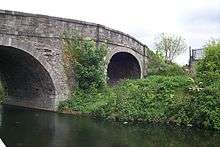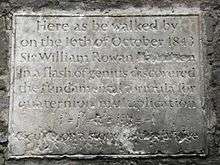Cabra, Dublin
| Cabra An Chabrach | |
|---|---|
| Suburb of Dublin | |
 Cabra Location in Ireland | |
| Coordinates: 53°21′57″N 6°17′27″W / 53.365714°N 6.290789°WCoordinates: 53°21′57″N 6°17′27″W / 53.365714°N 6.290789°W | |
| Country | Ireland |
| Province | Leinster |
| County | County Dublin |
| Population (2002) | |
| • Urban | 22,740 |
| Time zone | WET (UTC+0) |
| • Summer (DST) | IST (WEST) (UTC-1) |
| Irish Grid Reference | O133369 |
Cabra (Irish: An Chabrach, meaning "the poor land") is a suburb on the northside of Dublin city in Ireland. It is approximately 2 kilometres (1.2 mi) northwest of the city centre, in the administrative area of Dublin City Council. It was commonly known as Cabragh until the early 20th century. Cabra is also a parish in the Fingal South West deanery of the Roman Catholic Archdiocese of Dublin. It is served by the Church of Christ the King.[1]
Transport and access
Cabra is served by Dublin Bus. The 2 main routes for the area are the 120 Ashtown via Cabra West/East to Parnell Street/Ballsbridge and 122 Ashington, Cabra West/East, City to Drimnagh. Routes 38/a/b and Nitelink 39N serve Cabra Road, while 37, 39, 39a,70, 70N serve Navan Road Super route 46A also stops close by on North Circular Road, while the 4, 9, 83 and 140 serve nearby Phibsboro.
Suburban rail stops in the rundown Broombridge railway station in Cabra, en route to Maynooth. As part of the government's Transport 21 strategy, there are plans to extend the Dublin light rail system, Luas. By linking the present "red line" to Dublin Airport, there would be stops at local areas like Liffey Junction and the new Dublin Institute of Technology development at Grangegorman.
The main Dublin to Cavan road the N3 travels through Cabra linking up with M50 Junction 6 Blanchardstown.
History
From about 1480, the manor of Cabra was held by a branch of the Plunket family, later ennobled as Earls of Fingall, whose main residence was Dunsoghly Castle near Finglas.
There are three contiguous townlands called "Cabra", each in a different civil parish: Castleknock, Glasnevin and Grangegorman. The three met at the gate lodge of "Cabragh House", which is today the situation of the roundabout at the junction of Ratoath Road and Drumcliffe Road. "Cabragh House" was located where the current Canon Burke Senior Citizens Flats complex stands. Completed in 1598, it was first occupied by the Seagrave Family, who could trace their linage back to the Viking invasion of Ireland. The mansion was the home of the hanging judge Lord Norbery until he died in 1831 and, unusually for Catholics at the time, the Seagrave family managed to acquire it again. Charles Segrave, whose son was the famous racing driver Henry Segrave, who was the first person to hold both the land and water speed records simultaneously, lived there until 1912. The big house was bought by Dublin Corporation by way of a CPO in 1939 for the construction of local authority housing and the historic house was razed to the ground.
For hundreds of years the area mostly comprised fields and open countryside on the edge of the city. It was not until the 1920s that large scale housing developments took place. Many of the people who moved to the new suburb were from the rooms and tenement buildings of the city centre.
Quarry Road was originally called Quarry Lane after a small quarry which was situated near where the current statue of Our Blessed Lady is located at the roundabout with Fassaugh Road (which originally was called Fassaugh Lane.) This quarry was filled in the early part of the 1900s and the family who lived in the Homestead grew cabbages on the reclaimed land.
The Industrial Revolution brought the construction of the Royal Canal in 1790 and the laying of the Dublin-Galway railway line of which both went through the heart of the area. From about 1880-1930, Cabra was a prominent market garden centre and a giant lairage, where cattle being brought to market at Hanlon's Corner were kept in pens and grazing fields.
Famous former residents
Famous people from Cabra include singer-songwriter Eleanor McEvoy, world champion boxer Steve Collins, author and journalist Gene Kerrigan, actor Michael Gambon and Frank Grimes, actress and singer Angeline Ball, singer Dickie Rock and multi-time WWE world champion Sheamus (real name Stephen Farrelly).
Numerous footballers hail from Cabra, including Republic of Ireland international goalkeeper Wayne Henderson. Also, Eamonn Fagan and Liam Whelan, both from St. Attracta's Road. Liam was one of the Manchester United Busby Babes who died in the Munich air disaster of 1958. Connaught Bridge was later renamed in memory of Liam Whelan. The former Leeds United and Irish player and manager Johnny Giles also originally hails from the area. Roddy Collins, former manager of Bohemians, Shamrock Rovers and Maltese side Floriana lived in Cabra before being appointed manager of Cork City.
The suburb's most infamous former resident was John Toler, 1st Earl of Norbury, otherwise known as the hanging judge, who lived at Cabragh House on the corner of the present day Fassaugh Avenue and Rathoath Road. He constantly harrangued and insulted Robert Emmet before sentencing him to death, never listened to any defence for those appearing before him and meted out the death sentence for the most trivial offences. Where he could not in law impose a death penalty, he ordered deportation to Australia. At a single assizes, he sentenced to death 198 individuals, laughing and joking as if the whole thing was a comedy.
One of the world's most famous mathematicians, William Rowan Hamilton, who freed algebra from the commutative postulate of multiplication -that the order or sequence of factors does not determine the result - was associated with the area. There is a plaque in his honour at the Broom Bridge.
Commerce
Cabra West has many factories in the industrial park and also along Bannow Road, one of the most famous of these being the Batchelors beans factory.
Religious Buildings
The Roman Catholic church of Christ the King was built during the years following the Eucumenical Congress of 1932. It seemed appropriate to employ John J. Robinson of Robinson and Keefe to design the new church, as he had been Architect for all the structures (Phoenix Park, Merrion Road, O'Connell bridge etc.) built for the Congress. The church which is cross shaped in plan was built in red brick with a huge statue of Christ integrated into the tower which is on the axis of the approach road. An Architect's perspective drawing of the church exists in the Irish Architectural Archive in Merrion Square. This church shares many features with St. Therese Mount Merrion which was built by the same Architect some 20 years later. Robinson is also famed as being Architect to Galway Cathedral.
Noteworthy locations


Broom Bridge, also known as Brougham Bridge, is a small bridge along Broombridge Road which crosses the Royal Canal in Cabra. The bridge is named after William Broom, one of the directors of the Royal Canal company. Broom Bridge is the location where Sir William Rowan Hamilton, following a 'eureka experience', first wrote down the fundamental formula for quaternions on 16 October 1843, which is to this day commemorated by a stone plaque on the northwest corner of the underside of the bridge. The text on the plaque reads:
| “ | Here as he walked by on the 16th of October 1843 Sir William Rowan Hamilton in a flash of genius discovered the fundamental formula for quaternion multiplication i² = j² = k² = ijk = −1 and cut it on a stone of this bridge. | ” |
Given the historical importance of the mathematical contribution, mathematicians have been known to make a pilgrimage of sorts to the site.
Local organisations
- Order of Malta Ambulance Corps local branch, providing training in first-aid and nursing skills, and voluntary community care services for over 30 years, and a related national youth organisation, the Order of Malta Cadets for 10- to 16-year-olds
- The FÁS training centre, present in Cabra since 1978, was closed down on 24 December 2010. Courses, staff and instructors were sent to other training centres on the city. One of the apprenticeship courses, Construction Plant Fitting, has since been moved to a temporary home in Baldoyle, near the FÁS Baldoyle Training Centre. Visit the CP Fitters' website here
- Christ the King GNS. Local girls primary school (GNS) see Education in the Republic of Ireland. The primary school is unique insofar as it was built close to the edge of the adjoining road, and encloses a sheltered playground. The primary School and associated hall was designed by Robinson and Keefe Architects.
- Cabra Technical School was designed by Robinson and Keefe Architects.
References
- ↑ Official website - Cabra parish